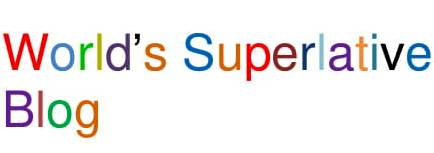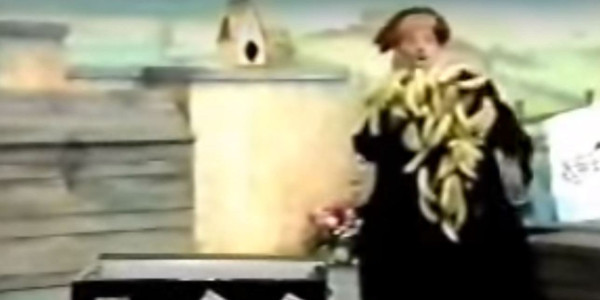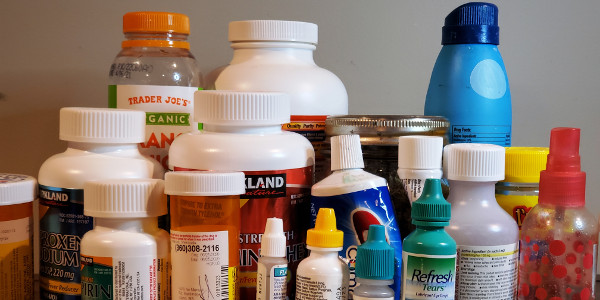The Banana Man
The Banana Man was one of the few completely positive memories I’ve retained from childhood. I should never have tried to track him down.
When I was seven, a sacred family tradition was that every Saturday at noon we’d gather in front of our little black and white TV. That’s when The Sealtest Big Top came on. It was a kid’s circus show, sponsored, not surprisingly, by the Sealtest Dairy. We snuggled together on the sofa to eat my mother’s fabulous grilled cheese sandwiches, always including a big slice of tomato which burrowed into the melted cheese. For drinks we had another of my mother’s specialties: chocolate sodas. They were made with seltzer water, Hershey’s chocolate syrup, and milk (presumably Sealtest). After the chocolate and milk were stirred into the syrup, a foamy, spritzy head formed at the top, giving a pleasant tickle to the nose as we drank it.
The ad-heavy Sealtest Big Top featured numerous regulars, including “Sealtest Dan, The Muscle Man”. Sealtest Dan, as I just learned, was Dan Lurie, a runner up for Mr. America in the mid-1940’s. He won the Most Muscular Man trophy several years in a row. He was outfitted in a black cape, sandals, and faux leopard skin bikini trunks. In a typical act, Sealtest Dan would heft a barbell fitted with two hundred-plus pounds of weights. After he finished his reps, a girl about my age would rush onto the stage and offer him a tall glass of milk (you can guess the brand). Simultaneously, Jack Sterling, the snappy ringmaster, averred that Sealtest milk grew big muscles and strong bones; after seeing Dan press that barbell in his leopard skin bikini trunks, there could be little doubt that this was true. Then the girl stood on her tiptoes to palpate Dan’s formidable biceps, while exaggeratedly mouthing the word, “WOW!” In reply, Dan modestly grinned. The segment ended with ringmaster Jack saying, “Extra nutritious and extra delicious! Get the best, get Sealtest.” Those weren’t the days of subtle messaging.
Despite the allure of Sealtest Dan, to me the most memorable act was The Banana Man. (He was not referred to as The Sealtest Banana Man. This was probably because bananas were not a dairy product, and thus not marketed by Sealtest). The Banana Man shuffled onto the stage wearing a baggy tuxedo jacket that went down to his knees, and a bright red wig that looked like a mop head that had been soaked in some sort of carmine dye. He smiled wanly at the live audience, perfunctorily bowed, and began his magic.
While humming to himself in a buzzy falsetto, The Banana Man reached into his tux and began extracting an extraordinary variety of objects: musical instruments, a huge magnet, watermelons, an enormous comb and mirror set, a music stand, a waste basket, a giant hand, and a bottle of milk (by now, you can probably deduce the brand). Each time something emerged from the interior of his tux he brandished it aloft, and in that same irritating but alluring falsetto said “Ooh!”, or “Wow!” The latter, of course, echoed the little girl’s reaction to Sealtest Dan’s biceps, and seemed like a good summary of the entire spectacle of The Sealtest Big Top. Of all the objects The Banana Man produced, the most dazzling was bunch, after bunch, after bunch of bananas. In my seven-year-old mind, which I carried to adulthood until I was very recently disabused of this belief (more on that soon), these were full, heavy bunches of real bananas. How he did it was never a question; it was magic, after all. The point is that he did, and his feat was both wonderful and hilarious. I think I shared his professed amazement as each bunch came forth, silently mouthing his falsetto “Ooh’s” along with him.
The spectacular extractions went on and on until the contents of the tux filled four miniature train cars, which had been set up on the stage to receive them. Wow! What a show–both amazing, and roll-on-the-floor funny. During my entire childhood I rarely felt closer to my family as we all ate those grilled cheese sandwiches, washed them down with chocolate sodas, and laughed uproariously at The Banana Man.
A week or so ago, a bunch of bananas in the fruit basket for some reason triggered thoughts of The Banana Man. Hmm, it occurred to me, I could Google him! Perhaps I could find out who he really was. And maybe even see one of his performances on YouTube. Unfortunately, Google came through, loud and clear…
I learned that there were actually two Banana Men. The original was Adolph Proper, an Austrian who emigrated to the US, reinvented himself as “A. Robbins,” and invented the persona of The Banana Man. Before a performance, his tux jacket was intricately loaded with 60 pounds of stuff, which took up to 2 ½ hours to prepare. Alas, Adolph Proper died in 1950. But someone named Sam Levine stepped up to the plate. He bought Proper’s entire wardrobe, equipment, and shtick, and continued the Banana Man act in venues including Captain Kangaroo and The Ed Sullivan Show.
After learning the identity of The Banana Man—or, more correctly I guess, The Banana Men—I found a video of one of their performances. This one, on Captain Kangaroo, was by Banana Man II, Sam Levine. He was the same Banana Man I saw on The Sealtest Big Top. And, WOW, was it depressing! I hadn’t remembered that he looked so sad and disheveled. I hadn’t remembered how cheap and tawdry all the things were that he pulled out of his pathetic tux jacket. And most distressing of all, I had no idea that the 300 bananas he produced were tacky imitations. Not only weren’t they real bunches of bananas, they weren’t even fake bunches–they appeared to be hanging from a string, like fish caught on a line of hooks. And they certainly weren’t hefty, rich yellow fruits—they were merely cores of springs covered with pale yellow cloth which Adoph Proper had fashioned lovingly by hand. To pack the tux, the Banana Men compressed the springs, then jammed the flattened fruits into various pockets. Then, as they were pulled out during a performance, the springs sprung, turning the cloth coins into very rough simulacra of real bananas. So much for the magic! Even at the tender age of seven, how could I have been so fooled? Or was I? Maybe I appreciated the ruse, but was happy to suspend my disbelief to enjoy The Banana Man with my family.
As Thomas Wolfe famously said, You Can’t Go Home Again. That’s because when you do, what you find will not be what you remember. And, quite possibly, what you find will be worse. Old Tom sure nailed my Banana Man memories! Alas, after going home again, I now carry two parallel reels in my head: The first one is the Banana Man of my youth, pulling huge bunches of real bananas out of his tux jacket, while my family and I howl in amazement and delight. The second reel is the Banana Man of my adulthood—a bit tattered and worn, awkwardly pulling fake objects only tangentially related to bunches of real bananas out of that same tux. Perhaps these two reels are two different versions of the reality of the Banana Man–mutually exclusive, but both still true. In any case, the more recent reel still nags at me.
I wonder if The Banana Man is a cautionary tale. For example, lately—probably triggered by the pandemic—I’ve been involved in a flurry of Zoom convocations with old high school buddies. Most of us haven’t been in touch for decades. Interestingly, and to my mild distress, we almost exclusively reminisce about ye olde high school days rather than discuss what everyone is doing now. And once again, some of my long-held memories of those days are being challenged. I wonder if we would do better to leave the past fallow, keeping the old memories, right or wrong, intact.
Maybe. But it could be that some of our pleasant memories of yesteryear are actually accurate, and could be made even more vivid by collective recollection. That is, maybe old memories don’t always go in the Banana Man direction. For example, during one of those Zoom chats some of my high school buddies fondly recalled a funny high school stunt of mine that I had completely forgotten about. That recollection made me feel good, and connected. So maybe revisiting old memories isn’t all bad. Maybe you actually can go home again, at least once in a while. I’ll think about that, perhaps while making a grilled cheese sandwich. With a fresh tomato slice, of course, and a chocolate soda on the side.



